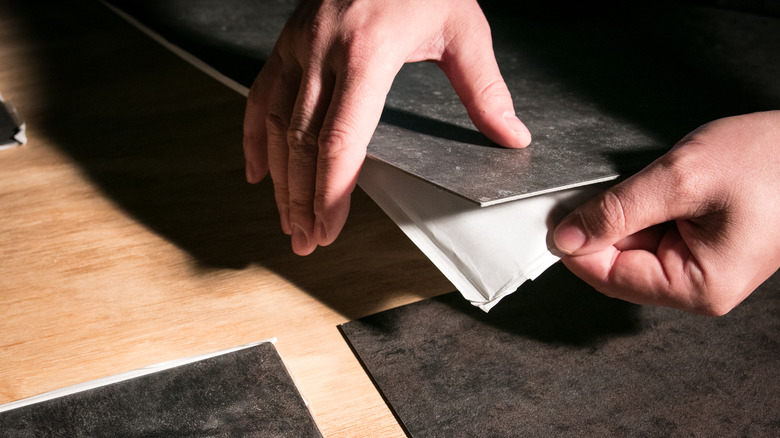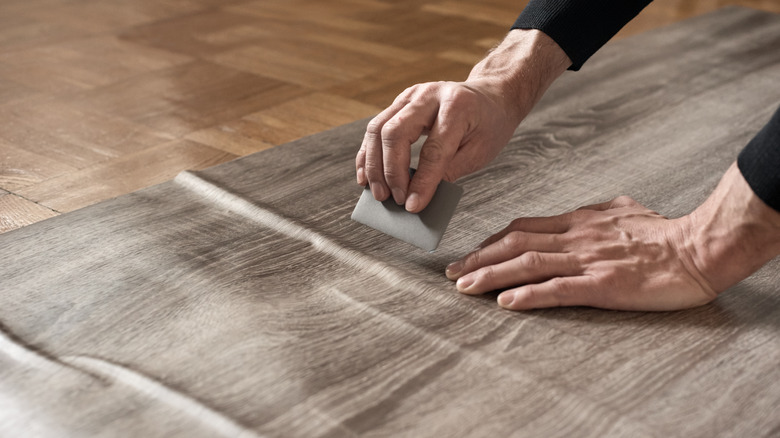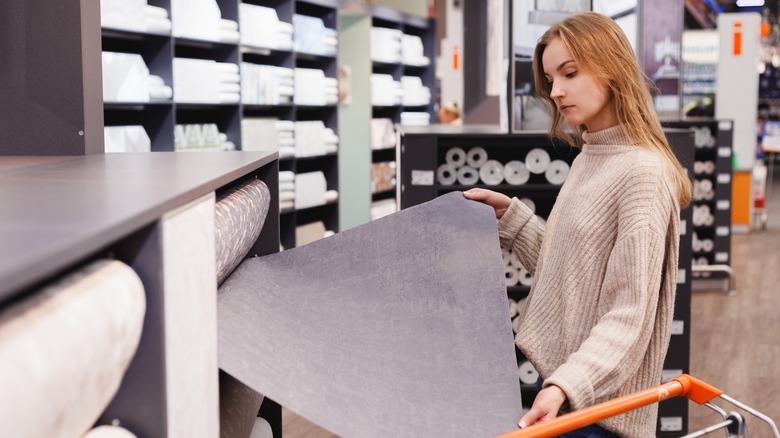Why You Should Think Twice Before Using Peel-And-Stick Vinyl
Peel-and-stick vinyl floor tiles are the go-to for budget renovation jobs or when you want to change your floor in a flash. They are even used for finishing top-of-the-line bird cages. But for all the pros, there are some distinct downsides: peel-and-stick vinyl tiles and wallpaper wrinkle easily, the tiles are hard to cut and apply straight, the adhesive is far from easily removable, and there are those health-harming VOCs to worry about.
The tiles come in an enormous array of colors and designs. Wall tiles commonly come in 12" x 12" squares. Floor tiles come square or as planks. There's also peel-and-stick vinyl wallpaper, which, again, is multi-hued and patterned and comes in rolls like regular wallpaper. Today, these products are sold everywhere, from big box hardware stores like The Home Depot to indie shops on Etsy. You can expect peel-and-stick floor tiles to set you back between $1 and $5 a square foot.
It's essential to get the right tiles for the job. For example, peel-and-stick vinyl floor tiles are designed to withstand repeated footfall but not to adhere tightly to a vertical wall. Plus, in many cases, this type of tile isn't much cheaper than — or is even the same price as — "real" tiles. Peel and stick tiles come in more materials than the flat plastic surfaces you might expect and see more commonly. You can get everything from glass and metal to natural wood and stone veneer. Each finish, of course, comes at a corresponding cost.
Purchase and installation problems
Peel-and-stick tiles and other products are pitched mostly as DIY products. In other words, anyone can install them with a few simple tools. The trouble is, this doesn't always prove correct. It's easy to get the measurements wrong, and if you realize this halfway through the project, you can't easily peel the product off. Due to the unforgiving stickiness, first-time users end up with pattern alignment issues, wrinkles, and bubbles. If you muck up badly, you'll need to call the professionals. Many traditional tilers, painters, or wallpaper installers, however, have little to no experience with peel-and-stick vinyl products. You may pay more for a fix only to get lackluster results.
Peel-and-stick films tend to stretch, and you can't use any stick-on vinyl products on textured, dirty, recently painted, cracked, or damaged surfaces or in rooms with high humidity. The tiles (and wallpaper) sometimes lift at the edges, and can sometimes become discolored over time.
Home life and the environment
Are you preparing your home for sale? Peel-and-stick vinyl tiles or wallpaper might seem like a cheap fixer-upper solution, but a word of caution: The arguably "cheap" (let's go with faux) look of these products can signal to prospective buyers that you skimped on the pre-sale renovation. These stick-on building materials are more likely to be damaged from dropped items, pet claws, and kid's toys than their more permanent or solidly constructed counterparts. Shoes and furniture scuff them. Peel-and-stick vinyl anything is a home renovation product that doesn't last as long as you'd think.
Finally, but perhaps most importantly, there are environmental concerns. On the macro scale, peel-and-stock vinyl products are made from PVC or polyvinyl chloride. During the manufacturing of PVC, harmful chemical compounds are released into the atmosphere. Some industry specialists, like Green Building Supply, consider this a problem; they won't sell any PVC products. Vinyl products may also negatively impact indoor air quality by emitting volatile organic compounds (VOCs) and phthalates. You may find that the tiles you install have a long-lasting and distinctly unappealing chemical smell.


